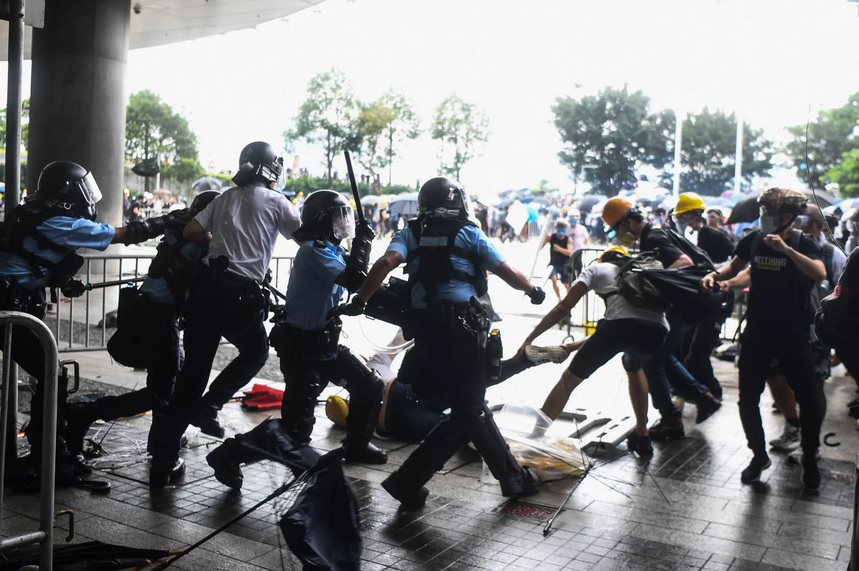.
By Ken Abramowitz, President & Founder, SaveTheWest
See the sources for this article and more research in the Additional Reading section.
Governmental instability is rising tremendously throughout both democracies and dictatorships, each of which occupy about half of the world’s population.
Which of these two forms of government are more unstable? Which will collapse first?
Before we approach these questions, we must first we try to understand their sources of instability.
In regards to democracies, the U.S. and U.K. in particular have become unstable because the gap between right and left has become too wide. America’s government-run educational system has been taken over by the intolerant and socialistic left, which has turned learning institutions into indoctrination chambers. Most of our students in secondary schools and colleges are able to graduate without understanding the U.S. Constitution or Bill of Rights, basic civics or history. If you doubt this, see “America At The Precipice,” a major research report by STW editor Jon Sutz, that contains some of the shocking metrics. A sampling:
- 82% of American adults cannot identify two rights stated in the Declaration of Independence.
- Less than 50% of American adults understand the basic purpose of the Constitution, or can identify even one of their rights under it.
- Only 26% of Americans can identify all three branches of the government — a sharp decline from 2011, when 38% could do so.
Further, America’s children are being infused in our schools with a belief that socialism, or communism, are ideal political-economic systems. Surveys conducted in 2019 reveal that 70% of Millennials say that they would vote for a socialist for elective office, and 36% “approve of communism” (up from from 28% in 2018). The climax of this indoctrination is an overt, explicit desire to overthrow the U.S. government, to install communist totalitarianism, as articulated by this group of Revolutionary Communists:
Deprived of knowledge and appreciation of our governmental system, and infused with notorious, oppressive ideologies, our children emerge from our schools unprepared to become functional, patriotic American citizens, yet we allow them to vote when they reach 18 years of age. Similarly, new (legal) immigrants are under-educated, but are allowed to vote once they become citizens.
In the democracy of Israel, the ideological gap between the two leading parties is not as wide as in the U.S., but the population is confused and split, more due to the personality of the two leaders, Benjamin Netanyahu and Bennie Gantz, and only secondarily due to the issues. In general, though, the challengers are leftists who would seek to implement some elements of socialism, which can sound good, even though it has bankrupted almost every country that embraced it during its 150 years of existence.

In contrast, the key dictatorships are increasingly unstable, due primarily to the rise of the Internet and social media, which has fueled the spread of knowledge and the desire for the freedom that protesters observe in the key democracies. For example:
- China: The rare example of a successful dictatorship has seen 8 months of protests in its semi-autonomous Hong Kong island. China signed a treaty with the British in 1984, guaranteeing basic democratic human rights until 2047. The mainland Chinese government reneged on that treaty in 2019, 28 years prematurely, thereby provoking huge protests, leading to the deaths of at least 50-100 people.

- Iran: It has an incredibly mismanaged dictatorship, but it has been successful in creating the single largest Islamist terrorist organization in the world, Hezbollah. Iran operates a worldwide network of physical, narco, and cultural terror organizations in 30 countries in the Middle East, Africa, Europe, and Latin America, with a collective array of over 400,000 terrorists. Yet when the messianic rulers suddenly raised the price of gasoline from a highly subsidized $0.35 to a more realistic $1.00, protests grew spontaneously in 100 cities, leading to the deaths of nearly 150 protesters, and according to other reports, many more.
- Iraq: Protesters have grown weary of Iranian infiltration of their government and society. The Iranian consulate in Najaf was burned down, and Iraqi authorities, acting under Iranian orders, have killed over 350 protesters, since the protests began in October.

So which are more unstable, democracies or dictatorships?
And what are the ramifications for U.S. national security interests?
Over time, dictatorships should prove less stable, as their populations increasingly demand the rule of law, human rights, and growing economies, to create more jobs and wealth. Democratic instability is more transitory, as new parties and personalities run for office, and mold their messages better to the majority of voters.
One unfortunate result of this worldwide political turmoil, however, is that the dictatorships might seek to attack their adversaries, in order to build up domestic support for their inherently corrupt governments. The democracies must become for more alert to the dictatorships’ propensity for both external subversion, and war, as their internal threats rise.
Watch out for un-forecastable wars and/or skirmishes in 2020, particularly from Iran, the #1 enemy of America!
VIDEO: Revolutionary Communist Party activists rally outside the RNC
Sino-British Joint Declaration – Wikipedia
Hong Kong Protests Turn Violent – Foreign Policy
Iran has been the #1 largest state sponsor of global terrorism – SaveTheWest
Hizballah – The Investigative Project on Terrorism
AP Analysis: Iran protests point to turmoil in the future – AP
Ken’s Thought of the Week: Negotiations with Iran are guaranteed to fail – Save The West
Why is Iran conspiring with Mexican drug dealers? – Foreign Policy
Iraqis keep up anti-regime demos despite PM’s vow to quit – YahooNews
Protesters burn down Iranian consulate in southern Iraq | World news – The Guardian
4 protesters killed in Baghdad, raising toll in Iraq clashes since Oct. to 340 – The Times of Israel
.
.
.






